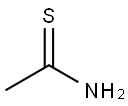-
外観
白色〜うすい黄色, 結晶〜結晶性粉末又は塊
-
種類
チオアセトアミドは、通常研究開発用試薬製品として一般に販売されている物質です。容量の種類には、25g、100g、500gなどがあり、常温で取り扱われる場合も、冷蔵で取り扱われる場合もある試薬製品です。
有機合成原料などの他、疾患モデル動物作製用の試薬としても用いられることがあり、炎症・免疫疾患モデル作製に有用です。人体に有害な物質であるため、正しく取り扱うことが必要です。また、試薬製品は研究開発用途以外での使用を行うことはできません。
-
性質

図1. チオアセトアミドの基本情報
チオアセトアミドは、分子量75.16、融点113〜116℃であり、常温においては無色から黄色の結晶もしくは結晶性粉末です。メルカプタン様臭気を呈します。水及びエタノールに溶けやすく、アセトンに溶けにくい物質です。水への溶解度は16.3g/100ml水です。
分子のC2NH2Sの部分は平面構造であり、C-SとC-N間の距離は1.713 と 1.324 Åです。これは両方が多重結合、すなわちπ共役系であることを示しています。
-
溶解性
水に可溶 (16.3g/100ml水)。水及びエタノールに溶けやすく、アセトンに溶けにくい。
-
解説
チオアセトアミド (英: Thioacetamide) とは、分子式C2H5NSで表される、チオアミドの一種の有機化合物です。
別名には、「アセトチオアミド」「エタンチオアミド」「アセトイミドチオ酸」などがあります。CAS登録番号は、62-55-5です。チオアセトアミド水溶液と多くの金属カチオンはそれぞれ対応する硫化物を作り、古典的定性分析で使われます。人体に対して有害な物質です。
-
用途
染料、 医薬?医薬中間体、合成中間体、写真薬
-
合成

図2. チオアセトアミドの合成
チオアセトアミドは、と五硫化二リンの合成により得られます。
-
説明
Thioacetamide (TAA) is not known to occur in nature. It is
prepared by heating ammonium acetate and aluminum sulfide.
-
化学的特性
Thioacetamide is combustible, crystalline compound. Slight mercaptan odor.
-
使用
Thioacetamide is a carcinogen, a hepatotoxicant. Thioacetamide induces acute chronic liver injury through the activation of protein synthesis of RNA, DNA, and gamma-glutamyl transpeptitase. Thioacetamide has been used in the synthesis of [email?protected] nano-array core-shell structure.
-
定義
ChEBI: A thiocarboxamide consiting of acetamide having the oxygen replaced by sulfur.
-
一般的な説明
White crystals with a mercaptan odor.
-
空気と水の反応
Slightly water soluble.
-
反応プロフィール
Thioacetamide reacts with aqueous acid to generate hydrogen sulfide. Forms addition compounds and sulfides with salts of heavy metals. Hydrolyzed by acids or bases .
-
危険性
Toxic by ingestion and inhalation, a possible
carcinogen.
-
火災危険
Flash point data on Thioacetamide are not available; Thioacetamide is probably combustible.
-
使用用途
チオアセトアミドの主な用途は、染料、医薬品および医薬品中間体、合成中間体、写真・印刷薬品です。例えば、カドミウムイオンの溶液にチオアセトアミド水溶液を加えた後に加温することで、硫化カドミウムが得られます。この硫化カドミウムは、黄色顔料であるカドミウムイエローの主成分です。
このほか、チオアセトアミドは、古典的定性分析におけるの供給源であり、金属硫化物の沈殿試薬 (均質沈殿法) 、金属イオンの系統分析の分属試薬に使用されています。
-
化学性质
融点112~114℃
-
関連する反応
チオアセトアミドの化学反応

図3. チオアセトアミドと金属イオンの反応
光によって変質する可能性があり、燃焼すると分解して、有毒な蒸気 (窒素酸化物NOx、硫黄酸化物SOxなど) を生じます。チオアセトアミド水溶液と多くの金属カチオンはそれぞれ対応する硫化物を作ることから、チオアセトアミドは定性分析においてしばしば用いられる物質です。
具体的には、ニッケル、鉛、カドミウム、水銀や、ヒ素、アンチモン、ビスマス、銀、銅 (I) などの反応で硫化物が沈殿します。また、水溶液にして基質と反応させた後、加水分解により硫化物を生じることから、有機、無機合成において使用されています。
-
有害性情報
チオアセトアミドの有害性
チオアセトアミドについて、指摘されている有害性は下記の通りです。
- 飲み込むと有害
- 遺伝性疾患の可能性
- 発がんの可能性
- 肝臓の障害のおそれ
- 長期にわたる又は反復ばく露による肝臓の障害
取り扱いの際は適切な保護具を身に着け、粉じん、蒸気、スプレーを吸入しないように気をつけることが必要です。皮膚や眼も接触しないようにします。作業場は局所排気装置を備えていることが望ましいです。
-
保管方法
チオアセトアミドの保管情報
チオアセトアミドは、法規制を受ける化学物質ではありません。ただし、前述の通り人体に対する有害性が報告されているため、適切な管理が必要です。
常温で保管されることもありますが、容器は遮光し、冷蔵庫 (2~10°C) に密閉して保管するのがより安全です。また、強酸化剤とは反応するため、混触を避ける必要があります。
-
安全性プロファイル
Confirmed carcinogen
with experimental carcinogenic,
neoplas tigenic, tumorigenic, and teratogenic
data. Poison by ingestion and intraperitoneal
routes. Moderately toxic by subcutaneous
route. Human mutation data reported. An
experimental teratogen. Experimental
reproductive effects. Exposure has caused
liver damage. When heated to
decomposition it emits very toxic fumes of
NOx and SOx. See also SULFIDES and
MERCAPTANS.
-
職業ばく露
Thioacetamide is used as a replacement for hydrogen sulfide in qualitative analyses. Thioacetamide has been used as an organic solvent in the leather, textile, and paper industries; as an accelerator in the vulcanization of buna rubber; and as a stabilizer of motor fuel.
-
発がん性
Thioacetamide is reasonably anticipated to be a human carcinogenbased on sufficient evidence of carcinogenicity from studies in experimental animals.
-
環境運命予測
TAA’s production and use as a substitute for hydrogen sulfide in
the laboratory may result in its release to the environment
through various waste streams. If released to air, TAA’s estimated
vapor pressure indicates that it will exist solely as a vapor
in the ambient atmosphere. Vapor-phase TAA will be degraded
in the atmosphere by reaction with photochemically produced
hydroxyl radicals; the half-life for this reaction in air is estimated
to be 18 h. TAA was not biodegraded by activated sludge
after 5 days, and therefore may be resistant to biodegradation
in the environment. Hydrolysis is not expected since amides
hydrolyze very slowly under environmental conditions. An
estimated bioconcentration factor for TAA suggests that the
potential for bioconcentration in aquatic organisms is low. TAA
is expected to be highly mobile in soil, and to volatilize into the
atmosphere from moist soil surfaces. In an aquatic environment,
most of the substance will leave via volatilization and is
not expected to adsorb to solids.
-
合成方法
酢酸アンモニウムと硫化アルミニウムとの反応や,アセトニトリルと硫化水素との反応,またはアセトアミドの硫化反応で得られる
-
輸送方法
UN2811 Toxic solids, organic, n.o.s., Hazard Class: 6.1; Labels: 6.1-Poisonous materials, Technical Name Required.
-
純化方法
Crystallise the amide from absolute diethyl ether or *benzene. Dry it at 70o in a vacuum and store it over P2O5 at 0o under nitrogen. (It develops an obnoxious odour on storage, and absorption at 269nm decreases, hence it should be freshly recrystallised before use). [Beilstein 2 IV 565.]
-
不和合性
Incompatible with oxidizers (chlorates, nitrates, peroxides, permanganates, perchlorates, chlorine, bromine, fluorine, etc.); contact may cause fires or explosions. Keep away from alkaline materials, strong bases, strong acids, oxoacids, epoxides.
-
廃棄物の処理
Consult with environmental regulatory agencies for guidance on acceptable disposal practices. Generators of waste containing this contaminant (≥100 kg/mo) must conform with EPA regulations governing storage, transportation, treatment, and waste disposal. Treatment in an incinerator, boiler or cement kiln.





